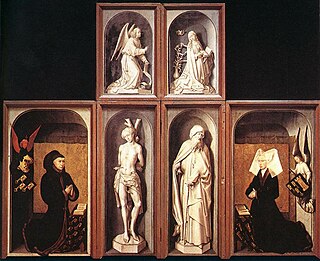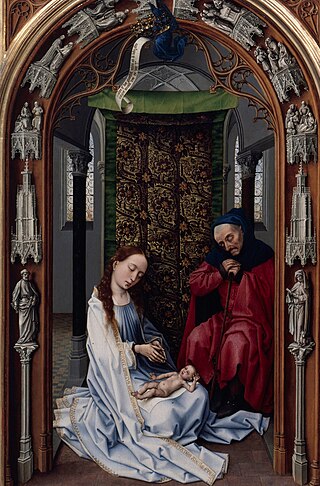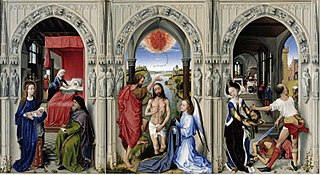Related Research Articles
Hans Memling was a German-Flemish painter who worked in the tradition of Early Netherlandish painting. Born in the Middle Rhine region, he probably spent his childhood in Mainz. During his apprenticeship as a painter he moved to the Netherlands and spent time in the Brussels workshop of Rogier van der Weyden. In 1465 he was made a citizen of Bruges, where he became one of the leading artists and the master of a large workshop. A tax document from 1480 lists him among the wealthiest citizens. Memling's religious works often incorporated donor portraits of the clergymen, aristocrats, and burghers who were his patrons. These portraits built upon the styles which Memling learned in his youth.

Early Netherlandish painting is the body of work by artists active in the Burgundian and Habsburg Netherlands during the 15th- and 16th-century Northern Renaissance period, once known as the Flemish Primitives. It flourished especially in the cities of Bruges, Ghent, Mechelen, Leuven, Tournai and Brussels, all in present-day Belgium. The period begins approximately with Robert Campin and Jan van Eyck in the 1420s and lasts at least until the death of Gerard David in 1523, although many scholars extend it to the start of the Dutch Revolt in 1566 or 1568–Max J. Friedländer's acclaimed surveys run through Pieter Bruegel the Elder. Early Netherlandish painting coincides with the Early and High Italian Renaissance, but the early period is seen as an independent artistic evolution, separate from the Renaissance humanism that characterised developments in Italy. Beginning in the 1490s, as increasing numbers of Netherlandish and other Northern painters traveled to Italy, Renaissance ideals and painting styles were incorporated into northern painting. As a result, Early Netherlandish painters are often categorised as belonging to both the Northern Renaissance and the Late or International Gothic.

The Mérode Altarpiece is an oil on oak panel triptych, now in The Cloisters, in New York City. It is unsigned and undated, but attributed to Early Netherlandish painter Robert Campin and an assistant. The three panels represent, from left to right, the donors kneeling in prayer in a garden, the moment of the Annunciation to Mary, which is set in a contemporary, domestic setting, and Saint Joseph, a carpenter with the tools of his trade. The many elements of religious symbolism include the lily and fountain, and the Holy Spirit represented by the rays of light coming through from the central panel's left hand window.

Petrus Christus was an Early Netherlandish painter active in Bruges from 1444, where, along with Hans Memling, he became the leading painter after the death of Jan van Eyck. He was influenced by van Eyck and Rogier van der Weyden and is noted for his innovations with linear perspective and a meticulous technique which seems derived from miniatures and manuscript illumination. Today, some 30 works are confidently attributed to him. The best known include the Portrait of a Carthusian (1446) and Portrait of a Young Girl ; both are highly innovative in the presentation of the figure against detailed, rather than flat, backgrounds.
The decade of the 1470s in art involved some significant events.

The Beaune Altarpiece is a large polyptych c. 1443–1451 altarpiece by the Early Netherlandish artist Rogier van der Weyden, painted in oil on oak panels with parts later transferred to canvas. It consists of fifteen paintings on nine panels, of which six are painted on both sides. Unusually for the period, it retains some of its original frames.

A donor portrait or votive portrait is a portrait in a larger painting or other work showing the person who commissioned and paid for the image, or a member of his, or her, family. Donor portrait usually refers to the portrait or portraits of donors alone, as a section of a larger work, whereas votive portrait may often refer to a whole work of art intended as an ex-voto, including for example a Madonna, especially if the donor is very prominent. The terms are not used very consistently by art historians, as Angela Marisol Roberts points out, and may also be used for smaller religious subjects that were probably made to be retained by the commissioner rather than donated to a church.

The Donne Triptych is a hinged-triptych altarpiece by the Early Netherlandish painter Hans Memling. It consists of five individual panel paintings: a central inner panel, and two double-sided wings. It was painted for the soldier, courtier and diplomat Sir John Donne, probably sometime between the late 1470s or early 1480s, and contains portraits of Donne, his wife and daughter. It is kept in the collection of the National Gallery, London, with the panels still in their original frames.

The Braque Triptych is a c. 1452 oil-on-oak altarpiece by the Early Netherlandish painter Rogier van der Weyden. When open, its three half-length panels reveal, from left to right, John the Baptist, The Virgin Mary with Jesus and Saint John the Evangelist, and on the right, Mary Magdalene. When the wings are closed, the work shows a vanitas motif of a skull and cross.

The Miraflores Altarpiece is a c. 1442-5 oil-on-oak wood panel altarpiece by the Early Netherlandish painter Rogier van der Weyden, in the Gemäldegalerie, Berlin since 1850. The three panels are each 71 x 43 cm and show, from left to right, a portrait of the Holy Family, a Pietà and Christ's appearance to Mary—a chronological reading of the birth, death and resurrection of Jesus, with Mary the focus of both wings. The altarpiece examines Mary's relationship with Christ at different stages of his life. It is notable for its use of colour, distinguished by its use of whites, reds and blues, and use of line—notably the line of Christ's body in the central panel—and, typically of van der Weyden, its emotional impact.

The Virgin and Child with Canon van der Paele is a large oil-on-oak panel painting completed around 1434–1436 by the Early Netherlandish painter Jan van Eyck. It shows the painting's donor, Joris van der Paele, within an apparition of saints. The Virgin Mary is enthroned at the centre of the semicircular space, which most likely represents a church interior, with the Christ Child on her lap. St. Donatian stands to her right, Saint George—the donor's name saint—to her left. The panel was commissioned by van der Paele as an altarpiece. He was then a wealthy clergyman from Bruges, but elderly and gravely ill, and intended the work as his memorial.
Craig S. Harbison was an American art historian specialising in 15th and 16th-century Flemish and Northern Renaissance painting. He was Professor Emeritus of Art History at the University of Massachusetts Amherst. While attending Princeton University in the early 1970s, he studied iconographic analysis under Erwin Panofsky and Wolfgang Stechow. He had previously studied at Oberlin College, Ohio.

Lotte Brand Philip was a German art historian, professor and expert on Netherlandish art, one of the most notable and incisive experts on 14th- and 15th-century art to have studied under Erwin Panofsky. Born a Christian of Jewish descent, she resisted state intimidation to leave Germany, only moving to the United States in 1941. She began her new life as a jewelry designer, before establishing a career as an art historian and writer, and taking professorship at a number of universities, including New York University and Queens College, Flushing. During her long career, Brand wrote highly regarded books and monographs on artists such as Jan van Eyck, Albrecht Dürer and Hieronymus Bosch, and in 1980 became emeritus at Queens. Brand Philip died on May 2, 1986, in New York City.

The St John Altarpiece is a large oil-on-oak hinged-triptych altarpiece completed around 1479 by the Early Netherlandish master painter Hans Memling. It was commissioned in the mid-1470s in Bruges for the Old St. John's Hospital (Sint-Janshospitaal) during the building of a new apse. It is signed and dated 1479 on the original frame – its date of installation – and is today still at the hospital in the Memling museum.

The St John Altarpiece is a c. 1455 oil-on-oak wood panel altarpiece by the Early Netherlandish painter Rogier van der Weyden, now in the Gemäldegalerie, Berlin. The triptych is linked to the artist's earlier Miraflores Altarpiece in its symbolic motifs, format and intention.

The Mystic Marriage of St. Catherine is a c. 1480 oil-on-oak painting by the Early Netherlandish painter Hans Memling, now in the Metropolitan Museum of Art, New York. The Virgin Mary sits on a throne in a garden holding the Child Jesus in her lap. Mother and child are flanked by angels playing musical instruments, with St Catherine of Alexandria to the left opposite St Barbara on the right. The male figure standing slightly behind the celestial group, presumably commissioned the painting as a devotional donor portrait.

The Annunciation is an oil painting by the Early Netherlandish Painter Hans Memling. It depicts the Annunciation, the archangel Gabriel's announcement to the Virgin Mary that she would conceive and become the mother of Jesus, described in the Gospel of Luke. The painting was executed in the 1480s and was transferred to canvas from its original oak panel sometime after 1928; it is today held in the Robert Lehman collection of the Metropolitan Museum of Art in New York.

Portrait of Maria Portinari is a small c. 1470–72 painting by Hans Memling in tempera and oil on oak panel. It portrays Maria Maddalena Baroncelli, about whom very little is known. She is about 14 years old, and depicted shortly before her wedding to the Italian banker, Tommaso Portinari. Maria is dressed in the height of late fifteenth-century fashion, with a long black hennin with a transparent veil and an elaborate jewel-studded necklace. Her headdress is similar and a necklace identical to those in her depiction in Hugo van der Goes's later Portinari Altarpiece, a painting that may have been partly based on Memling's portrait.

The Moreel Triptych is the name given to a 1484 panel painting by the Early Netherlandish painter Hans Memling. It was commissioned by the prominent Bruges politician, merchant and banker Willem Moreel and his wife Barbara van Vlaenderberch, née van Hertsvelde. It was intended as their epitaph at the chapel of the St. James's Church, Bruges, an extension they paid for, to the funerary church of Willem's family, where the couple intended to be interred in an underground tomb before the altar.

The Pagagnotti Triptych is an oil-on-wood triptych by Hans Memling produced circa 1480. The original was disassembled and separated, with the center panel held at the Uffizi gallery in Florence and the two wing panels at the National Gallery in London.
References
- ↑ Office of Communications and Marketing (2023-09-29). "In Memoriam: Art History Professor Emerita Barbara G. Lane". CUNY Graduate Center. Retrieved 2023-11-18.
- ↑ "Graduate Studies and Research Archived 2010-08-23 at the Wayback Machine ." Queens College. Retrieved on September 30, 2013.
- ↑ "Barbara Lane." Art History Program, Graduate Center, Queens College. Retrieved on October 1, 2013.
- ↑ "Grant number: FE-21359-87." National Endowment for the Humanities. Retrieved on September 30, 2013.
- ↑ "Grant number: FB-25517-88." National Endowment for the Humanities. Retrieved on October 1, 2013.
- ↑ "Frick Collection is the Exclusive U.S. Venue of the Most Comprehensive Exhibition of Memling’s Portraits" (PDF). Frick Collection. Retrieved on September 30, 2013.